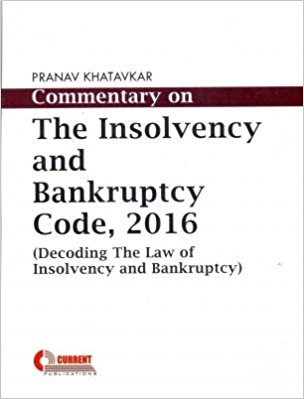BOOK REVIEW
Commentary on the Insolvency and Bankruptcy Code 2016 by Pranav Khatavkar
Vishwam Jindal reviews this new book on insolvency and bankruptcy law in India
 Commentary on the Insolvency and Bankruptcy Code 2016
Commentary on the Insolvency and Bankruptcy Code 2016

Pranav Khatavkar is a practicing advocate in the Bombay High Court and penned down one of the first commentary on the Insolvency and Bankruptcy Code 2016 ("Code"). The book was published in 2016, the same year as the Code was enacted. The book is divided into five parts and runs into nearly 300 pages.
Before delving into the substantive provisions of the Code, there is an introductory section that introduces the salient new concepts that the Code brings to the Indian jurisprudence. These concepts include: (i) Insolvency and Bankruptcy Board; (ii) Insolvency Professionals; (iii) Insolvency Professional Agencies; and (iv) Information Utility. Pranav has identified the relevant provisions applicable to these concepts in the Code and reproduced them, which will be helpful for anybody interested in the subject.
The introductory chapter then comprises flowcharts describing the: (i) corporate insolvency resolution process; (ii) Liquidation Process; (iii) Fresh Start Process; (iv) Insolvency Resolution Process; and (v) Bankruptcy Order for individuals and partnership firms. These flowcharts are helpful for a reader as they summarise the process and Pranav clearly identifies the key steps involved. However, there is a real scope of improvement on how the information is presented and the detail of information required in the flowcharts.
Pranav then delves into the five parts of the book starting with Part I that deals with preliminary section of the Code. The methodology and structure of the book is such that the bare provision of the Code is reproduced followed by a synopsis. The synopsis is where Pranav offers his comments, analysis and thoughts. However, not every provision of the Code is followed by a synopsis and some of the key provisions are also missed out. For example, there is no synopsis to section 3 (Definitions) as one would normally expect.
The book continuously runs into parts without any sufficient notice that a part and/or chapter has ended. For instance, Part II begins from page 22 just a line after Part I finishes. Ideally, this should start from a fresh page in order for the reader to easily navigate through the book. This may seem minor but goes a long way when practitioners and lawyers are finding a provision or synopsis to meet strict deadlines, something very common in the world of insolvency and bankruptcy.
The synopsis for some of the provisions is very helpful and noteworthy. For instance, sections 7, 8, 9, 10, 12 and 14 (among others) of the Code are all followed by a synopsis that captures the key analysis that an insolvency practitioner and lawyer needs to know. The synopsis to sections 21, 25, 33, 36 are also remarkable and succinctly capture the legislative provision.
Pranav has done well to include synopsis for sections 47 - 54, however there is a real scope of improvement here as these provisions will be intensely debated in the times to come before courts and tribunals and their interpretation will be key to resolving crucial disputes.
The book ends with a section on 'Legal Implications of the Amendments to Allied Acts' and the 'Prescribed timeline for various processed under the Code'. Both these sections are very user friendly and will prove to be handy for the audience.
Nobody can dispute that the Code is still new, untested and at a nascent stage. It hasn’t been subject to legal arguments or has many precedents. Accordingly, this book will be a useful guide to navigate through the Code while it is in its early days. Needless to say that it is not as detailed as commentaries on other areas of law but that's something you cannot expect anyway from a legislation that hasn’t even turned one. Pranav has done well to capture his initial thoughts on the Code in this book. As mentioned in the preface "….thought is creative", this book has everything by its side to be a top seller as it continues to be updated and revised with legal developments and advancements to the insolvency jurisprudence in India.
- FIR Copy of Mahatma Gandhi assasination case
- Licito Concurso'20
- Rules for Licito Concurso '20- A National Legislative Drafting Competition
- Registration Form for Licito Concurso-20
- www.apexcourtweekly.substack.com
- www.lawupdater.com/wp/
- XIIIth K.K. Luthra Memorial Moot Court Competition 2017
- President of India Presented with the First Copy of the Book Statement of Indian Law Published by Thomson Reuters





